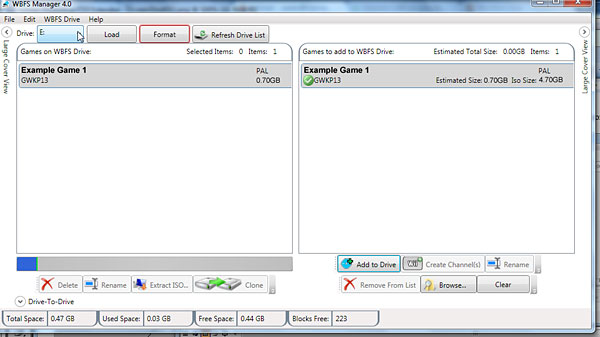Wbfs For Mac Os X Download
- Info: This is the only Mac OS-X compatible WBFS manager, so its worth to mention it! Note that the format function isn't very good with this manager, so please use an USB loader to.
- Download; WBFS Manager is a Convenient program for storing and converting Nintendo Wii data. Supports all game and data formats.
- WBFS system can be bought in use to format a drive on Mac as well. All you need for this purpose is a bit of knowledge about this system and instructions for formatting. If you currently have WBFS on your Mac and you wish to format a drive with it, the following steps can be followed:-How to Format a Hard Drive to WBFS on Mac 1.
- Download os x 10.7.5 for mac - OS X Lion Update 10.7.5: Update to Mac OS X 10.7.5, and much more programs. The 10.7.5 update is recommended for all OS X Lion users and includes general operating system fixes that improve the stability, compatibility and security of your Mac.
Download Wii Backup Fusion for Mac - Backup solution for Wii games that can scan local or DVD resources, create WBFS drives or partitions, verify games, store extensive details about each title, and more.
As many of you may know, WBFS for Mac OS X is an application that let's you put Wii games on a WBFS formatted hard drive with a mac. It is the only application for mac to do this as of present. However, it lacks some features its PC counterparts include, such as adding files in *.wbfs format to your drive.
This tutorial serves to provide a workaround for those who have used another backup manager on PC in the past and thus have *.wbfs backups already, or those who download in formats other than ISO.
Before we begin, you will need:
- Wine (to run WiiBackupManager for conversion purposes)
- X11 or XQuarts (most macs have this already but if you don't have it, you'll need to install it for wine either from download or from the OS X installation disc)
- A *.wbfs file
- A WBFS formatted hard drive
Step 1: Install Wine (and X11/XQuarts if you don't have it already). You can get wine from here (WineBottler includes a copy of wine). We will need this to run the PC utility WiiBackupManager to convert from WBFS to ISO. Now you may be wondering: 'Why not put the files on the drive from the PC app then?' The problem with that is, Wine doesn't recognize WBFS formatted drives though the mac. You won't be able to find the drive, however all the other features of the backup manager (including conversion) will work within wine.
Step 2: Download WiiBackupManager from this link. Open up the 32 bit exe in Wine.
Step 3:
 ' Find your WBFS file though the file explorer. Note that Z drive is your Macintosh HD. If you file is within your User folder, you'll be looking for 'My Computer -> Z: -> Users -> *yourname*.' Click okay once you have your WBFS file selected or the folder in which it is located.
' Find your WBFS file though the file explorer. Note that Z drive is your Macintosh HD. If you file is within your User folder, you'll be looking for 'My Computer -> Z: -> Users -> *yourname*.' Click okay once you have your WBFS file selected or the folder in which it is located.Step 4: Your game(s) should have appeared in WiiBackupManager now. Check the box beside the ones you wish to convert and select 'Transfer -> ISO.' You will then be presented a progress box on the right side of WiiBackupManager. Do not leave the WiiBackupManager window while the files are converting. It may glitch in Wine if you do. Don't worry, this should be a fairly fast process.
Step 5: Close WiiBackupManager and open WBFS for Mac OS X (Mountain Lion users will either need to use the launcher [download here] or use terminal to run the app with admin privileges). Connect your WBFS drive and click 'Add ISO.'

Step 6: Find the ISO you made with WiiBackupManager. If you're not running Mountain Lion, continue to step 7. However if you are running Mountain Lion, the next bit will be VERY useful. Finding your ISO might be tricky if you're running Mountain Lion as the program is running as the root user. You'll have a hell of a time finding your files. How we're going to fix this is simple. Click Applications in the sidebar. Navigate to the top drop down menu where it now says applications and select Macintosh HD. Find your user folder in the Users directory. You may wish to drag it to the sidebar for future reference as it will stay there for next time you use WBFS Manager for Mac. You should now be able to navigate through your user folder to find where you saved your ISO.
Step 7:
Wbfs Download 64 Bit
Select your ISO and it will transfer to the Hard Drive. After this you may wish to delete the ISO and repeat this process when you want to transfer the game again, or you may wish to use the larger ISO files instead of WBFS for future transfers.